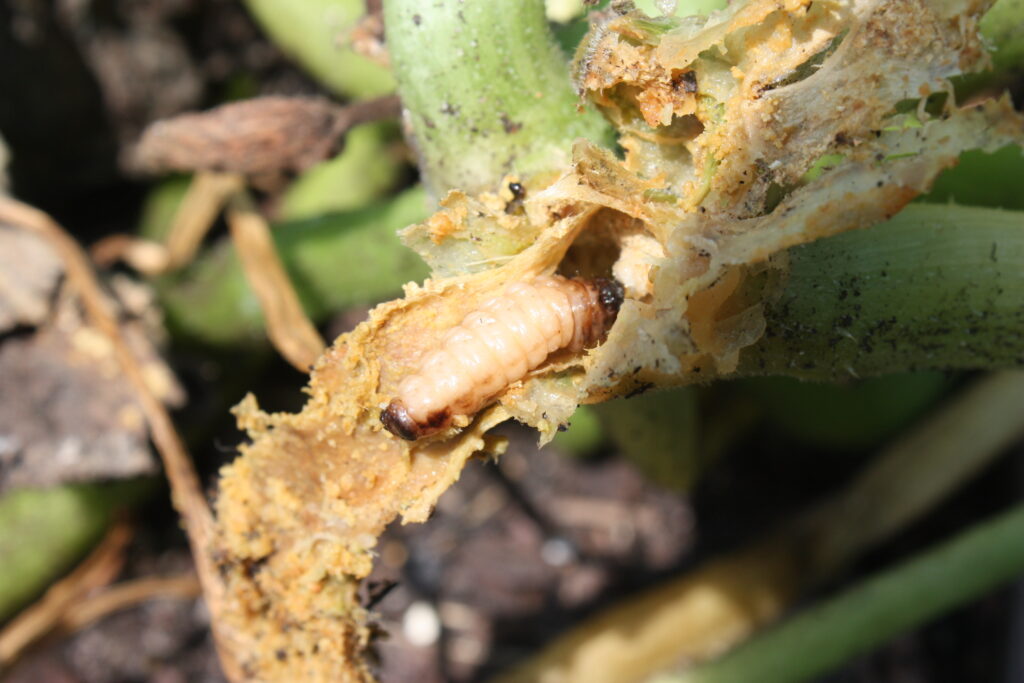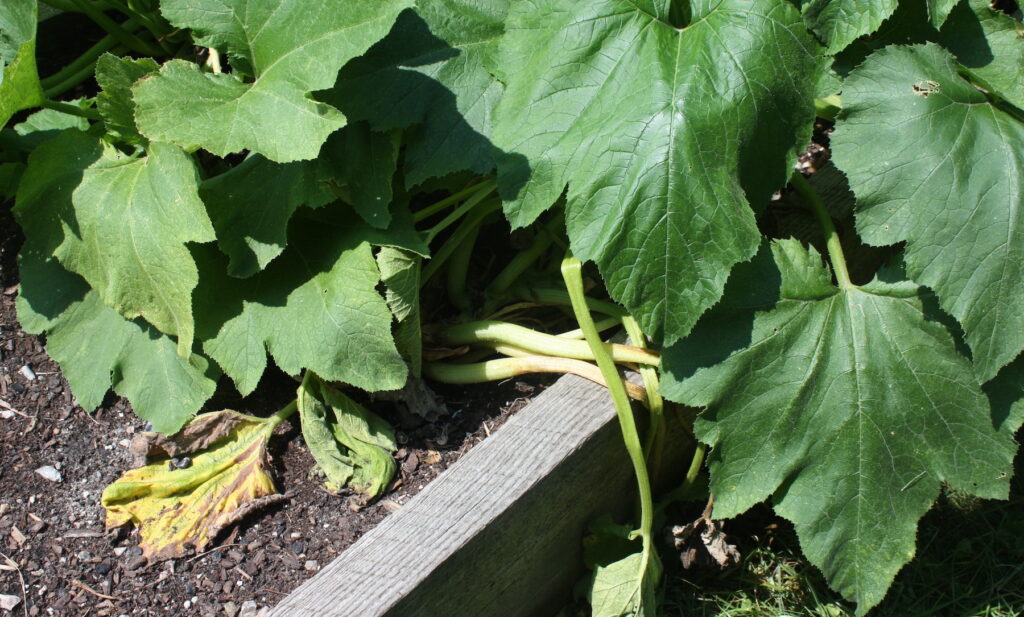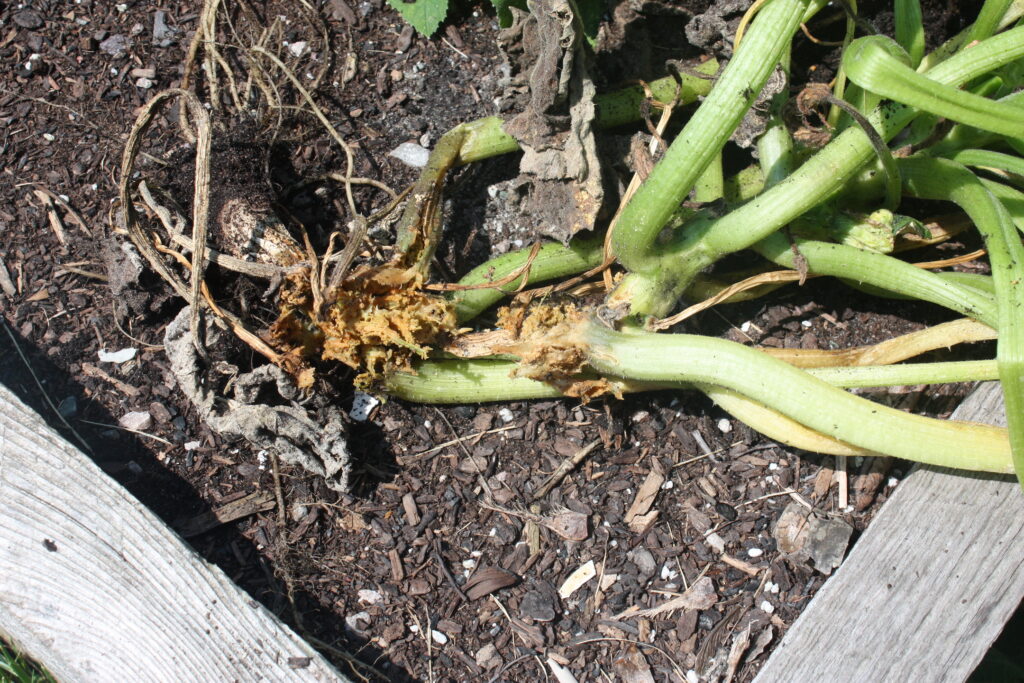
Pest: Squash vine borer (Melittia cucurbitae)
Pest identification and lifecycle, most common symptoms and crops affected:

Squash vine borer moths are day-flying moths with a 1 to 1.5 inch wingspan and bright orange-red markings. In flight, they look like wasps. There is thought to be only one generation per year in New England with adults emerging primarily in June and July. However, researchers in New Hampshire noticed a peak of adult moths caught in monitoring traps in late August in 2010 and 2013, which may suggest that a second generation is possible in some warmer years.
The moths fly slowly in zig-zags around plants and lay eggs singly on stems; eggs are usually found on the main stem near the base of the plant in the early summer, but are also found on leaf stalks, or, later in the summer, on stems closer to fruit. Upon hatching, larvae bore into stems (where they are protected from predators and insecticides). Thick-stemmed squashes, such as varieties in the Cucurbita maxima species (buttercup, hubbard, kubocha, etc.) are preferred egg laying sites. Cucurbita pepo species of squash (zucchini, acorn, etc.) are also frequently targeted, while Cucurbita moschata varieties (butternut, etc.) are usually the last choice of the squash vine borer moth, and thus considered partially “resistant.” Unless you use traps or scout fields for evidence of eggs or larvae, the first sign of squash vine borer infestation is often wilting vines in July and August. By that time, it is too late to do anything.

Management options:
Cultural:
Some growers monitor for the moths using Scentry Heliothis style net traps, baited with a squash vine borer sex pheromone lure from early June through early August, or later if you suspect the possibility of a second generation. The pheromone lure traps male moths, and therefore is not useful to reduce damage, only to monitor moth activity. If more than five moths per week are captured, then make two to four weekly applications of pesticides on bush-type squash and pumpkin varieties (see pesticide options below). A threshold of 12 moths per trap per week is used for vining varieties, as their greater ability to root at nodes (leaf or branch site) allows them to tolerate more borer injury. Timing is very important, so trap monitoring is not recommended for the casual gardener. Monitoring flight of adult moths through pheromone trapping can help to guide decision making regarding removal of row covers or exclusion netting. Row covers or exclusion netting can completely exclude adult moths from laying eggs, but they also exclude pollinating insects, vital for fruit set. Covers can be left on during peak moth flight, compromising early fruit set, but hopefully avoiding the worst of borer populations and producing a healthier crop of plants to then bear fruit pollinated after uncovering. On small scales, growers can also consider hand pollinating flowers and keeping plants covered for longer.
If evidence of larval feeding (sawdust-like frass near entrance holes) is found, then split open the stem to confirm the presence of larvae, which, by the way, may suggest more eggs are being laid so scout. Borers can be removed from vines if detected before much damage is done. Slit the stem longitudinally, remove the borer, then cover the wounded stem with moist soil at nodes above the point of injury to promote additional root formation. Some growers swear by puncturing the stem (and borer) many times over with a long thin pin or needle to reduce damage to the stem.

Pesticides approved for use in certified organic production (as a last resort):
Growers should scout their pumpkin and squash fields weekly for squash vine borer from late June through early August. Examine the base of vines for eggs. The squash vine borer can be killed with an insecticide and the recommendation would be spinosad (for example, Entrust for commercial growers or Monterey Garden Spray for home growers), but appropriate timing is crucial. Bt also works, but Bt breaks down more quickly. Bt aizawai (e.g., Agree WG) has been shown to work better than Bt kurstaki (e.g., Dipel). Either insecticide is only effective when applied for young larvae to eat before they bore into the stem. Once they are in the stem the insecticide will be useless. If you see the moths flying or find eggs, then two insecticide sprays, ideally applied to the base of the plants and timed five to seven days apart, will control newly hatching larvae before they are able to bore into the stem. Again, the timing is crucial and there is no point in spraying before you find evidence, or after the larvae bore into the stem.
Please note: This information is for educational purposes. Any reference to commercial products, trade or brand names is for information only, and no endorsement or approval is intended. Pesticide registration status, approval for use in organic production and other aspects of labeling may change after the date of this writing. It is always best practice to check on a pesticide’s registration status with your state’s board of pesticide control, and for certified organic commercial producers to update their certification specialist if they are planning to use a material that is not already listed on their organic system plan. The use of any pesticide material, even those approved for use in organic production, carries risk — be sure to read and follow all label instructions. The label is the law. Pesticides labeled for home garden use are often not allowed for use in commercial production unless stated as such on the label.
Source material attribution: Written by Eric Sideman, MOFGA crop specialist emeritus and informed by New England Vegetable Management Guide; Handbook of Vegetable Pests, A Capinera; ATTRA, UMass Vegetable Newsletter, URI Extension Fact Sheet and UNH Extension Fact Sheet.
For more in-depth information, read this resource from the University of New Hampshire.
